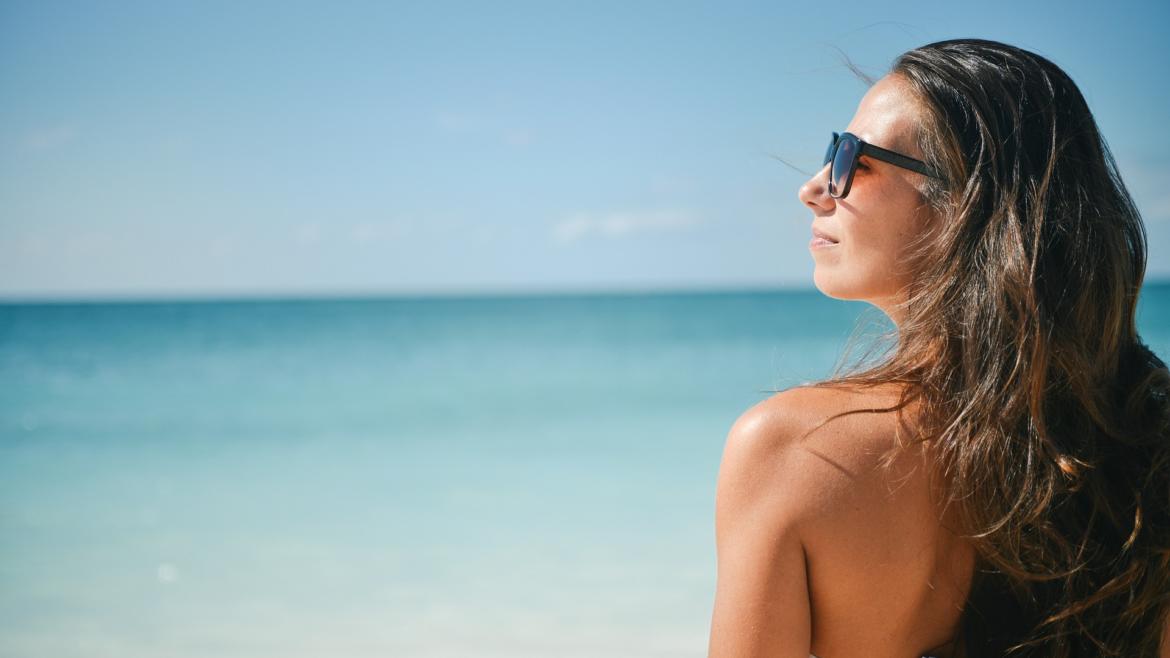IS THERE SUCH A THING AS A “HEALTHY TAN”?
Skin tanning is a protective reaction of the skin to damage caused by ultraviolet (UV) radiation of the sun or artificial strong UV sources (such as sunbed). Therefore, tanned skin is a sign of sun damage and there is no such thing as a “healthy tan”. If exposure to sunlight is intense and prolonged, it will cause sunburn.
Exposure to sunlight also causes the formation of moles and freckles, which in the long term causes skin aging. If the skin ages due to exposure to UV rays, it becomes thicker and flabby and loses elasticity faster; ‘age spots’, changes in skin color (discoloration), wrinkles, enlarged or dilated capillary vessels in the skin and skin cancer may appear.
WHAT DOES “UV INDEX” MEAN?
The Global Solar UV Index or the UV index is subject to the measured or predicted amount / intensity of ultraviolet (UV) sun radiation at a given location and on a given day. In many countries, daily weather forecasts contain this information, in the summer, to inform the public about the intensity of solar activity and the required scope of protection. Many weather forecasts on the internet contain information about the UV index.

IS THE RISK OF EXPOSURE TO SUNLIGHT GREATER FOR SOME PEOPLE? DO SKIN TYPE, HAIR COLOR OR EYE COLOR MATTER?
Yes. People with a light skin colour get burned faster in the sun than people with a darker skin colour. The more sensitive a person’s skin to the sun, the more important it is to protect the skin against the harmful effects of the sun. There are usually six different types of skin. Skin type means the characteristics of a person’s skin sensitivity to ultraviolet (UV) radiation.
CHECK YOUR SKIN TYPE
Skin phototypes – a numerical scheme for the classification of human skin color. According to the classification proposed in 1975 by American dermatologist Thomas B. Fitzpatrick, 6 types of skin (so-called phototypes) can be distinguished in humans, depending on the skin’s response to ultraviolet radiation.
The concept of classifying skin types depending on the response to ultraviolet radiation was created in order to be able to choose the right doses of radiation in the treatment of people with skin diseases.

IS THERE SUCH A THING AS SAFE TAN??
People in the UK are coming from a sun-deprived country. As we finally go away for annual leave to warmer places, we spend every minute of the day to secure beautiful golden tan.
This sudden lifestyle shift has meant that incidences of malignant melanoma, the most dangerous kind of skin cancer, have increased swiftly in the UK – by around 360% since the late 70s. So it’s important we protect ourselves from the sun.
There are more responsible ways to get a tan than basting and baking, which is likely to lead to burning that will peel and leave you pasty anyway.
Follow some simple guidelines to help you achieve a longer lasting tan and will reduce your risks in the sun.
⦁ Take it slow: Give your body time to ‘acclimatise’ by starting holidays with factor 50, then factor 40 and reduce until you find a healthy balance between tanning and sun protection. If at the end of the day you burn, tingle or itch, go back up to a stronger sun factor cream.
⦁ Never go in the sun between 11am and 2pm: high noon is when the sun is at its strongest and is most likely to burn you. Relax in the shade between 11am and 2pm and you’re much less likely to burn. Use this time to rehydrate, cool down and get some food to boost up electrolytes.
⦁ Protect your sensitive parts: face, nose, eyes and ears are more sensitive to the sun than the body, so wear a stronger factor on these areas and put a hat and sunglasses on especially 11-2. Make sure the hat covers the neck, which is often overlooked.
⦁ Stay smooth and moisturised: exfoliate to remove dead skin and use after sun to keep your skin moist at the end of the day.
⦁ The safest way to tan is to fake it. Using a spray tan that you apply yourself at home or by a professional will give you a golden tan without any of the health risks.
If you would like to know how we can help you to reduce appearance of skin damage after the busy summer period, boost your skin radiance and make you feel better, call us on: 0208 767 3888 and speak to our therapist who will assist you and answer all questions you might have.
Source: Nuffield Health

